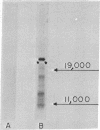Abstract
Analyses of amino-acid sequences of the total cell-free products programmed by the mRNA of MOPC-104E gamma light (L)-chain show that over 95% of the products have sequences of a distinct protein that correspond to the L-chain precursor. In this precursor an extra piece is coupled to the NH2-terminus of the mature L-chain. Analyses of products labeled with [3H]alanine, [3H]leucine, and [3H]proline demonstrate that the extra piece is composed of at least 18 residues. Analyses of [35S]methione-labeled product indicate that the extra piece may contain an additional NH2-terminal methionine, which is detected in about 10% of the molecules. Partial recovery of the NJ2-terminal methionine (alanine, leucine, and proline are recovered in yields close to theoretical, greater than 95%) suggests that it is the initiator methionine, which is known to be short lived in eukaryotes due to rapid hydrolysis. Thus, the extra piece seems to be 19 residues in length, and it contains one methionine at the NH2-terminus, three alanines at positions 2, 12, and 17, and five leucines at positions 6, 8, 10, 11, and 13. The close gathering of leucine residues, as well as their abundance (26%), suggest that the extra piece would be quite hydrophobic. Hydrophobicity seems to be a general property of the extra piece, since similar clusters of leucine were found in the precursors of 3 KL-chains (Burstein, Y. & Schechter, I. (1976) Biochem. J. 157, 145-151). The NH2-terminus of the mature MOPC-104E gamma L-chain is blocked by pyroglutamic acid. The fact that in the precursor a peptide segment precedes this NH2-terminus establishes that pyroglutamic acid is not the initiator residue for synthesis of the L-chain. Apparently, the pyroglutamic acid is formed by cyclization of glutamic acid or glutamine during cleavage of the extra piece to yield the mature L-chain.
Full text
PDF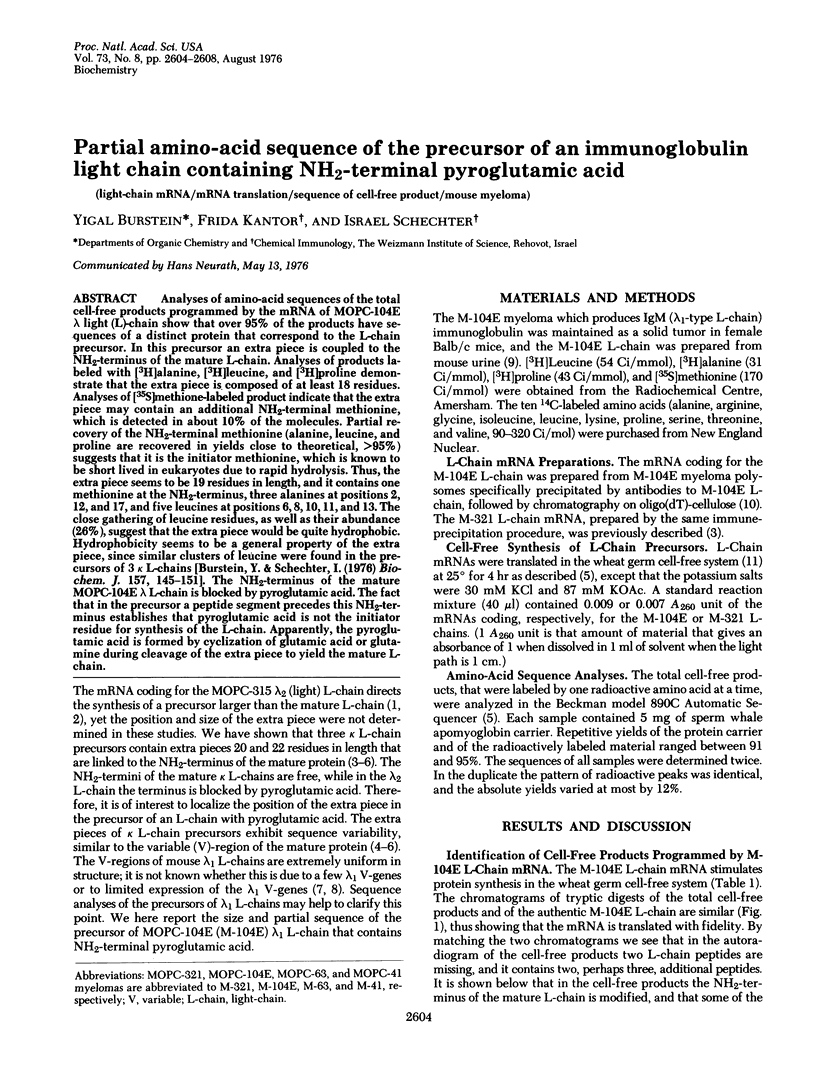
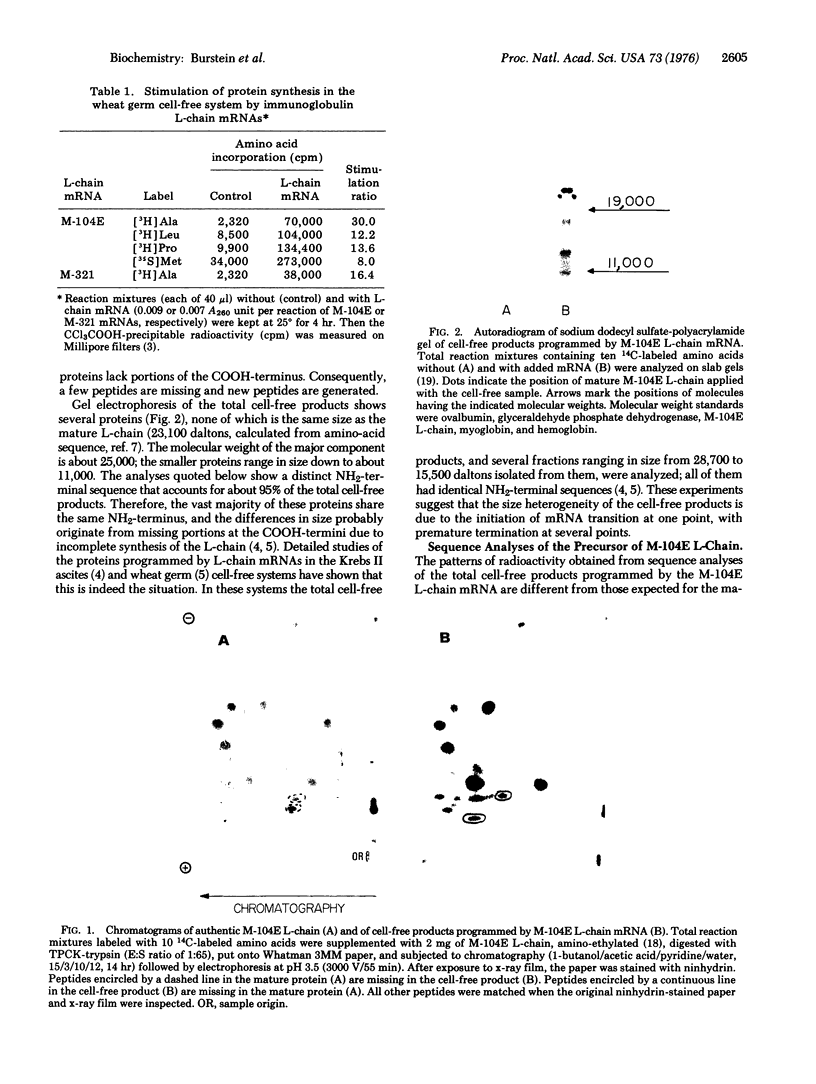
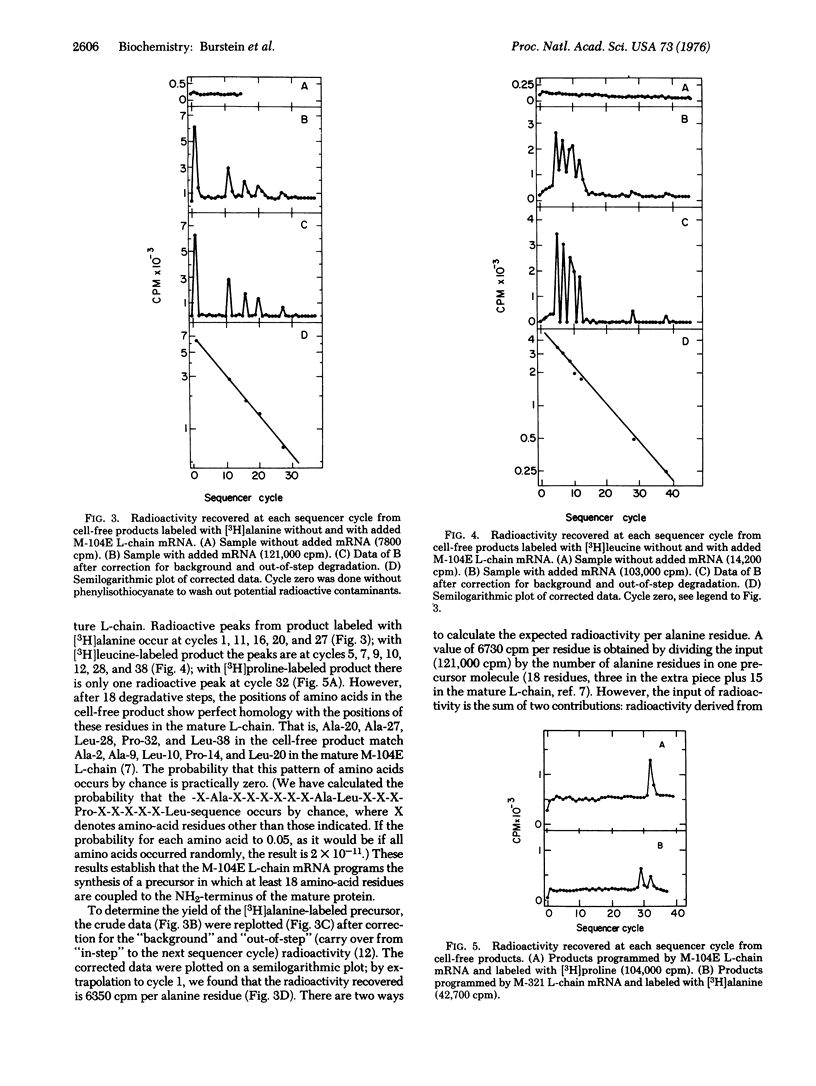
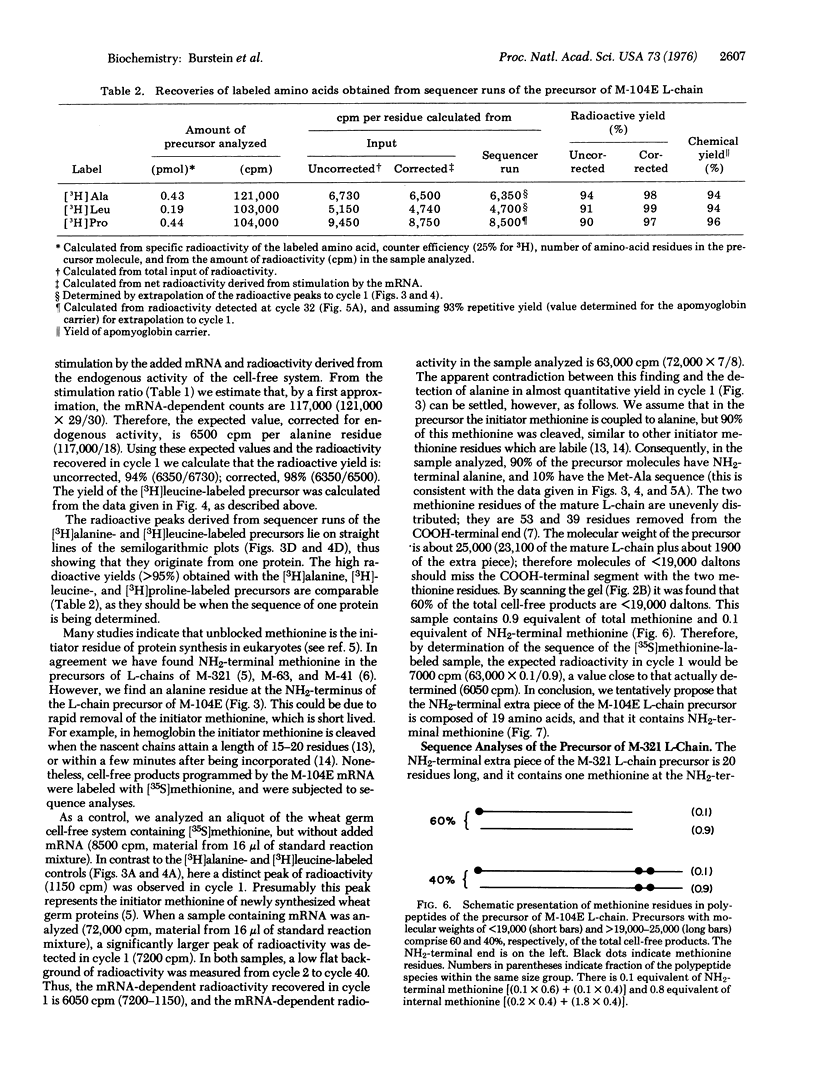
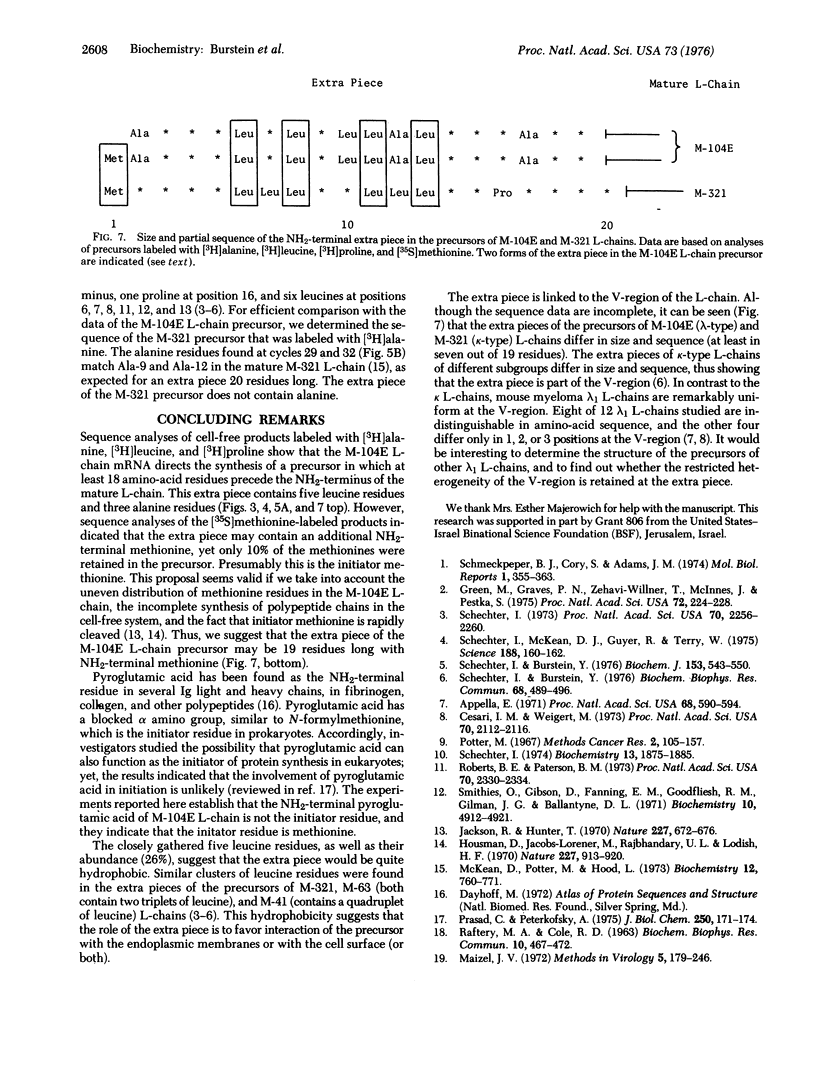
Images in this article
Selected References
These references are in PubMed. This may not be the complete list of references from this article.
- Appella E. Amino acid sequences of two mouse immunoglobulin lambda chains. Proc Natl Acad Sci U S A. 1971 Mar;68(3):590–594. doi: 10.1073/pnas.68.3.590. [DOI] [PMC free article] [PubMed] [Google Scholar]
- Cesari I. M., Weigert M. Mouse lambda-chain sequences. Proc Natl Acad Sci U S A. 1973 Jul;70(7):2112–2116. doi: 10.1073/pnas.70.7.2112. [DOI] [PMC free article] [PubMed] [Google Scholar]
- Green M., Graves P. N., Zehavi-Willner T., McInnes J., Pestka S. Cell-free translation of immunoglobulin messenger RNA from MOPC-315 plasmacytoma and MOPC-315 NR, a variant synthesizing only light chain. Proc Natl Acad Sci U S A. 1975 Jan;72(1):224–228. doi: 10.1073/pnas.72.1.224. [DOI] [PMC free article] [PubMed] [Google Scholar]
- Housman D., Jacobs-Lorena M., Rajbhandary U. L., Lodish H. F. Initiation of haemoglobin synthesis by methionyl-tRNA. Nature. 1970 Aug 29;227(5261):913–918. doi: 10.1038/227913a0. [DOI] [PubMed] [Google Scholar]
- Jackson R., Hunter T. Role of methionine in the initiation of haemoglobin synthesis. Nature. 1970 Aug 15;227(5259):672–676. doi: 10.1038/227672a0. [DOI] [PubMed] [Google Scholar]
- McKean D., Potter M., Hood L. Mouse immunoglobulin chains. Pattern of sequence variation among kappa chains with limited sequence differences. Biochemistry. 1973 Feb;12(4):760–771. doi: 10.1021/bi00728a028. [DOI] [PubMed] [Google Scholar]
- Prasad C., Peterkofsky A. Initiation by methionine of mouse immunoglobulin light chain containing NH-2terminal pyroglutamic acid. J Biol Chem. 1975 Jan 10;250(1):171–174. [PubMed] [Google Scholar]
- RAFTERY M. A., COLE R. D. Tryptic cleavage at cysteinyl peptide bonds. Biochem Biophys Res Commun. 1963 Mar 25;10:467–472. doi: 10.1016/0006-291x(63)90381-4. [DOI] [PubMed] [Google Scholar]
- Roberts B. E., Paterson B. M. Efficient translation of tobacco mosaic virus RNA and rabbit globin 9S RNA in a cell-free system from commercial wheat germ. Proc Natl Acad Sci U S A. 1973 Aug;70(8):2330–2334. doi: 10.1073/pnas.70.8.2330. [DOI] [PMC free article] [PubMed] [Google Scholar]
- Schechter I. Biologically and chemically pure mRNA coding for a mouse immunoglobulin L-chain prepared with the aid of antibodies and immobilized oligothymidine. Proc Natl Acad Sci U S A. 1973 Aug;70(8):2256–2260. doi: 10.1073/pnas.70.8.2256. [DOI] [PMC free article] [PubMed] [Google Scholar]
- Schechter I., Burstein Y. Identification of N-terminal methionine in the precursor of immunoglobulin light chain. Initiation of translation of messenger ribonucleic acid in plants and animals. Biochem J. 1976 Mar 1;153(3):543–550. doi: 10.1042/bj1530543. [DOI] [PMC free article] [PubMed] [Google Scholar]
- Schechter I., Burstein Y. Partial sequence of the precursors of immunoglobulin light-chains of different subgroups: evidence that the immunoglobulin variable-region gene is larger than hitherto known. Biochem Biophys Res Commun. 1976 Jan 26;68(2):489–496. doi: 10.1016/0006-291x(76)91172-4. [DOI] [PubMed] [Google Scholar]
- Schechter I. Partial amino acid sequence of the precursor of immunoglobulin light chain programmed by messenger RNA in vitro. Science. 1975 Apr 11;188(4184):160–162. doi: 10.1126/science.803715. [DOI] [PubMed] [Google Scholar]
- Schechter I. Use of antibodies for the isolation of biologically pure messenger ribonucleic acid from fully functional eukaryotic cells. Biochemistry. 1974 Apr 23;13(9):1875–1885. doi: 10.1021/bi00706a016. [DOI] [PubMed] [Google Scholar]
- Schmeckpeper B. J., Cory S., Adams J. M. Translation of immunoglobulin mRNAs in a wheat germ cell-free system. Mol Biol Rep. 1974 Mar;1(6):355–363. doi: 10.1007/BF00309570. [DOI] [PubMed] [Google Scholar]
- Smithies O., Gibson D., Fanning E. M., Goodfliesh R. M., Gilman J. G., Ballantyne D. L. Quantitative procedures for use with the Edman-Begg sequenator. Partial sequences of two unusual immunoglobulin light chains, Rzf and Sac. Biochemistry. 1971 Dec 21;10(26):4912–4921. doi: 10.1021/bi00802a013. [DOI] [PubMed] [Google Scholar]



